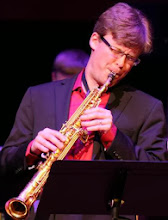David Sanborn has left the building. He was one of the most original voices in all of saxo-land, and he influenced generations of saxophonists. His thoughtfully curated "Night Music" program was my first time seeing Charlie Haden and the Liberation Music Orchestra, Sun Ra, Tim Berne, and too many other luminaries to count. The loss is impossible to measure.
This was my review of his album Hearsay, among some of my first pieces of professional writing. Travel in peace, David.
This review originally appeared in Saxophone Journal, January/February 1995.
Volume 19, No. 4
David Sanborn, Hearsay
David Sanborn presents the newest installment of super funk in grand fashion. The music is, as usual, killing. The band backs up Sanborn perfectly, no matter what the tempo, feel, or dynamic.
The opening tune, Savanna, has a James Brown kind of feeling, thanks to the trumpet of Earl Gardner and the tenor of Lenny Pickett. Marcus Miller’s over-dubbed bass clarinet lines make the ballads sound like Sanborn ballads. Miller has become an integral part of the Dave Sanborn recording legacy. His compositions, bass playing, and over-dubbing with that super fat bass clarinet have been shaping the sound of Sanborn’s recordings for as long as I can recall.
Marvin Gaye’s Got To Give It Up is a guaranteed treat for a variety of reasons. Not only is the groove ridiculous and the playing awesome, but if you are into that new subwoofer of yours, check out Marcus Miller’s entrance. I think that the low B string has been outlawed in some states! A few of my paintings nearly shook off the wall.
Some of the tunes on this CD rock a lot harder than the last few recordings. Ricky Peterson’s ever-present organ work is a great, background color, [sic] especially with the bass clarinet playing beneath it. John Purcell’s English horn is another welcome hue on track six, Mirage. The outstanding tune on this CD is Big Foot. The ultra-distorted guitar of Marcus Miller (that’s right, Marcus Miller) is rocking out of control. There seems to be all kinds of wild scratching noises and people yelling as Dave wails in his usual, inspired-sounding manner.
The timbre of Sanborn with the electric guitar is almost too funky to believe. The two musicians are so tightly locked in, it almost sounds like the fattest alto sound ever. Only a knowledgeable listener would even hear the guitar.
Track number nine, Ojiji, is the most unexpected, [sic] closing tune that I have ever heard on a Sanborn CD. The percussion and chanting of Don Alias, combined with a hard-grooving bass and tight horn line will make even the shyest wallflower want to hit the dance floor.
David Sanborn is the greatest and most influential alto player of the 70s and 80s. That honor is continuing as we approach the halfway mark of the 90s. As long as Sanborn records, we will listen and rejoice in the pure energy that he spills out. §

No comments:
Post a Comment